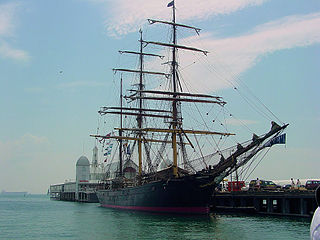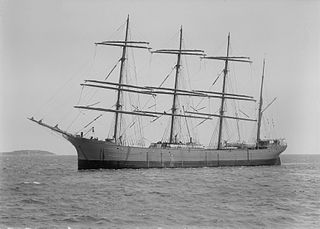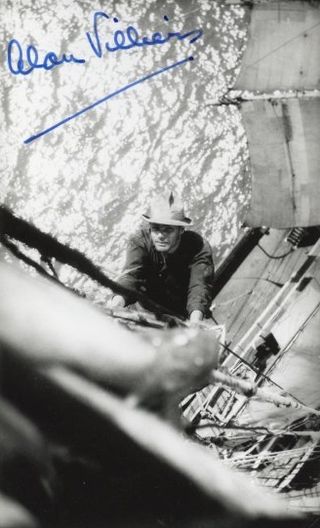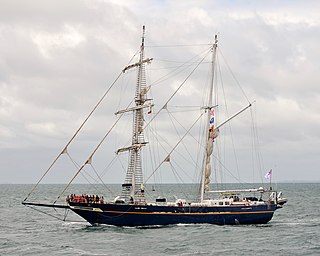Related Research Articles

Star of India is an iron-hulled sailing ship, built in 1863 in Ramsey, Isle of Man as the full-rigged ship Euterpe. After a career sailing from Great Britain to India and New Zealand, she was renamed, re-rigged as a barque, and became a salmon hauler on the Alaska to California route. Retired in 1926, she was restored as a seaworthy museum ship in 1962–3 and home-ported at the Maritime Museum of San Diego in San Diego, California. She is the oldest ship still sailing regularly and also the oldest iron-hulled merchant ship still afloat. The ship is both a California Historical Landmark and United States National Historic Landmark.

A barque, barc, or bark is a type of sailing vessel with three or more masts and mainmasts rigged square and only the mizzen rigged fore and aft. Sometimes, the mizzen is only partly fore-and-aft rigged, bearing a square-rigged sail above.

RRS Discovery is a barque-rigged auxiliary steamship built in Dundee, Scotland for Antarctic research. Launched in 1901, she was the last traditional wooden three-masted ship to be built in the United Kingdom. Her first mission was the British National Antarctic Expedition, carrying Robert Falcon Scott and Ernest Shackleton on their first, and highly successful, journey to the Antarctic, known as the Discovery Expedition.

Europa is a steel-hulled barque registered in the Netherlands. Originally she was a German lightship, named Senator Brockes and built in 1911 at the H.C. Stülcken & Sohn shipyard in Hamburg, Germany. Until 1977, she was in use by the German Federal Coast Guard as a lightship on the river Elbe. A Dutchman bought the vessel in 1985 and in 1994 she was fully restored as a barque, a three-mast rigged vessel, and retrofitted for special-purpose sail-training.

A barquentine or schooner barque is a sailing vessel with three or more masts; with a square rigged foremast and fore-and-aft rigged main, mizzen and any other masts.

James Craig is a three-masted, iron-hulled barque restored and sailed by the Sydney Heritage Fleet, Sydney, Australia.

Pamir was a four-masted barque built for the German shipping company F. Laeisz. One of their famous Flying P-Liners, she was the last commercial sailing ship to round Cape Horn, in 1949. By 1957, she had been outmoded by modern bulk carriers and could not operate at a profit. Her shipping consortium's inability to finance much-needed repairs or to recruit sufficient sail-trained officers caused severe technical difficulties. On 21 September 1957, she was caught in Hurricane Carrie and sank off the Azores, with only six survivors rescued after an extensive search.

Belem is a three-masted barque from France.

Lawhill was a steel-hulled four-masted barque rigged in "jubilee" or "baldheaded" fashion, i.e. without royal sails over the top-gallant sails, active in the early part of the 20th century. Although her career was not especially remarkable, save perhaps for being consistently profitable as a cargo carrier, in the 1930s Richard Cookson went on board and extensively documented Lawhill's internals and construction, which was later published in the Anatomy of the Ship series.

Iron-hulled sailing ships represented the final evolution of sailing ships at the end of the age of sail. They were built to carry bulk cargo for long distances in the nineteenth and early twentieth centuries. They were the largest of merchant sailing ships, with three to five masts and square sails, as well as other sail plans. They carried lumber, guano, grain or ore between continents. Later examples had steel hulls. They are sometimes referred to as "windjammers" or "tall ships". Several survive, variously operating as school ships, museum ships, restaurant ships, and cruise ships.

Polly Woodside is a Belfast-built, three-masted, iron-hulled barque, preserved in Melbourne, Victoria (Australia), and forming the central feature of the South Wharf precinct. The ship was originally built in Belfast by William J. Woodside and was launched in 1885. Polly Woodside is typical of thousands of smaller iron barques built in the last days of sail, intended for deep water trade around the world and designed to be operated as economically as possible.

Suomen Joutsen is a steel-hulled full-rigged ship with three square rigged masts. Built in 1902 by Chantiers de Penhoët in St. Nazaire, France, as Laënnec, the ship served two French owners before she was sold to German interest in 1922 and renamed Oldenburg. In 1930, she was acquired by the Government of Finland, refitted to serve as a school ship for the Finnish Navy and given her current name. Suomen Joutsen made eight long international voyages before the Second World War and later served in various support and supply roles during the war. From 1961 on she served as a stationary seamen's school for the Finnish Merchant Navy. In 1991, Suomen Joutsen was donated to the city of Turku and became a museum ship moored next to Forum Marinum.

Alan John Villiers, DSC was a writer, adventurer, photographer and mariner.

A jackass-barque, sometimes spelled jackass bark, is a sailing ship with three masts, of which the foremast is square-rigged and the main is partially square-rigged and partially fore-and-aft rigged (course). The mizzen mast is fore-and-aft rigged.

STS Young Endeavour is an Australian tall ship. Built by Brooke Marine, Young Endeavour was given to Australia by the British government in 1988, as a gift to celebrate Australian Bicentenary. Although operated and maintained by the Royal Australian Navy, Young Endeavour delivers up to twenty youth development sail training voyages to young Australians aged 16 – 23 each year. Navy personnel staff the ship and the Young Endeavour Youth Scheme coordinate the voyage program.

Picton Castle is a tall ship used for deep-ocean sail training and long distance education voyages. The ship was the subject of the television series Tall Ship Chronicles which documented her second voyage around the world in 2001. The ship has carried out seven world voyages to date - completing the seventh one in 2019. While flagged in the Cook Islands, the ship's unofficial home port is Lunenburg, Nova Scotia.

Potosi was a five-masted steel barque built in 1865 by Joh. C. Tecklenborg ship yard in Geestemünde, Germany, for the sailing ship company F. Laeisz as a trading vessel. Its primary purpose was as a "nitrate clipper" collecting guano in South America for use in chemical companies in Germany. As its shipping route was between Germany, Bolivia until 1870 but, during the "pacific War" was transferred to Chile, it was designed to be capable of withstanding the rough weather encountered around Cape Horn.

Danmark is a full-rigged ship owned by the Danish Maritime Authority and based at the Maritime Training and Education Centre in Frederikshavn, Denmark.

HMS Endeavour replica is a replica of HMS Endeavour, the bark commanded by Lieutenant James Cook when he charted New Zealand and the eastern coast of Australia.
The Philip Laing was a 19th-century sailing ship best known as the second immigrant ship to arrive in Dunedin, New Zealand, on 15 April 1848. Chartered by the New Zealand Company for this voyage the ship was carrying Scottish settlers, under the charge of the Rev. Dr. Thomas Burns.
References
- 1 2 3 4 5 6 7 8 9 10 11 12 13 14 15 16 17 18 Taylor, Roger (1 February 2008). Voyages of a Simple Sailor. Waltham Cross: The FitzRoy Press. ISBN 978-0955803505.
- 1 2 3 4 5 6 7 8 Hammond, Don. "The Loss of the Endeavour II". Don Hammond Image. Retrieved 19 February 2014.
- ↑ "Sailing ship towed after engine trouble". Port Angeles Evening News. 23 July 1969. Retrieved 21 February 2014.
- ↑ Johnson, Troy R (1996). The Occupation of Alcatraz Island. Urbana/Chicago: University of Illinois Press. p. 59. ISBN 0-252-06585-9.
- 1 2 3 4 Ingram, CWN (1984). New Zealand Shipwrecks 1795-1982. Wellington: Reed Publishing. ISBN 0589015109.
- ↑ Haigh, Val (2009). Tryste and the sea : the last two voyages. [S.l.]: Trafford On Demand Pub. p. 45. ISBN 978-1-4251-8659-3.
- ↑ "The Old Chelsea Sugar Boat". Shippey's. Archived from the original on 26 February 2014. Retrieved 21 February 2014.